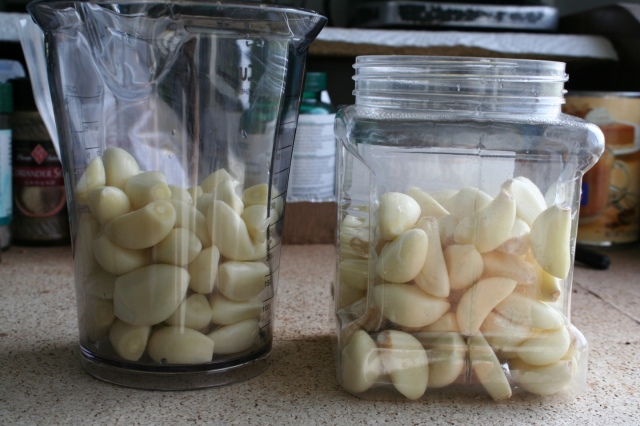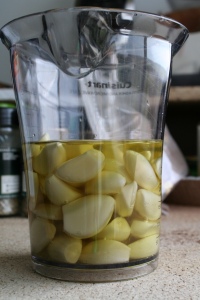I love garlic. When a recipe calls for one or two cloves, I use an entire head. I have never eaten a dish that had too much garlic in it. Hide’s a good sport and lets me use as much garlic as I want, except when we have guests.
Recently, it occurred to me that the only reason I wasn’t using more garlic was because I would get tired of peeling them. About one head was all I could do before I was too lazy to continue. That’s when I had the brilliant idea of making garlic paste.
I will say that I don’t know anything about canning or food preservation in general. While olive oil and salt strike me as pretty good preservatives, I honestly don’t know how long this garlic paste can keep (we go through it in a matter of weeks, not months) or whether it’s safe to eat. On the other hand, we haven’t seen any mold and we’re still alive. Still, I’m prepared to throw it out if it looks, smells or tastes funny to me.
Edit: Please see Michele Hays’s comment below about botulism and garlic paste!
Update: Please see Delora’s comment below about freezing garlic!
Garlic paste
- Buy peeled garlic. It turns out that they are, unfortunately (but not unexpectedly), more expensive than unpeeled garlic. So this step only makes sense if you are an insane garlic lover, like me.

 Trim the ends, as this will give you a chance to go over each clove individually. Throw out moldy ones and cut off bruised portions.
Trim the ends, as this will give you a chance to go over each clove individually. Throw out moldy ones and cut off bruised portions.- Cover the cloves with olive oil. Add salt for seasoning and to increase the preservation potential.
- Beat into a puree with an immersion blender, food processor or blender. We only have an immersion blender, and we love it.
- Pour into a jar for storage (we like to use mason jars). Pour some olive oil on top to keep the garlic paste in an anaerobic environment. You’ll likely have to work in batches to finish the rest of the cloves, depending on how much you buy.
What I like about using garlic paste, compared to using fresh cloves, is that now it’s much easier to use huge amounts of garlic. Rather than standing there peeling and slicing and mincing forever, I just take a great big spoonful (or two … or three …) of garlic paste and dump it in. It also cooks much faster and distributes much more evenly, particularly in liquids like sauces and stews. When I can convince Hide to make pizza again, I think it’ll also make a great pizza sauce.
The taste is not quite the same as larger pieces of garlic (there’s a sweetness to cooked garlic, when the pieces are big enough to taste), but the ‘garlicky’ flavour is there. More importantly, for the first time in my life I can finally put enough garlic into a dish to satisfy me. I still haven’t had a dish with too much garlic, though.



BE SUPER CAREFUL! Garlic in oil can harbor botulism – which needs an anaerobic environment to grow!!! If you’ve kept this in the fridge, it’s still recommended to use it within a week!
See
http://www.cdc.gov/nczved/divisions/dfbmd/diseases/botulism/
http://www.hc-sc.gc.ca/hl-vs/iyh-vsv/food-aliment/garlic-ail-eng.php
Thanks for the warning! Your links were more helpful and informative than the information I had come across before. I will be careful and edit my post to make sure that people see your comment.
I also buy huge quantities of the peeled garlic cloves and process it for future use. What I do though is pulse it in a food processor until it’s minced, then drop it by tablespoons onto a cookiesheet and freeze the little mounds. Then I transfer the frozen mounds to a ziploc freezer bag. This way it stays fresh, and I have pre-minced garlic that I can use whenever I like. Usually I just add it to whatever I’m cooking while still frozen since it thaws within 5mins, but sometimes I pull it a bit early and let it thaw first. I prefer the minced to garlic paste since it’s less likely to stick to the bottom of a pan and burn.
I’m with you, and luckily my partner agrees – you can’t add too much garlic to a dish!
Wow, that’s great idea! I freeze stuff all the time, so I don’t why it didn’t occur to me to do this, but that should take care of the botulism problem pretty well! I think I’m going to have to edit my post again. =)
I actually buy pre-frozen garlic paste – I think they add a little citric acid before they freeze it, as it has a slight sour taste.
At any rate, if you’re freezing it without the oil you are eliminating the anaerobic environment, so it’s less of a problem.
Since we don’t have a food processor, and liquid is needed for good results with an immersion blender (I think), the oil may have to stay. I suppose I could use water, which would provide an aerobic environment. Hmm.
Here’s more info on storing garlic – freezing garlic in oil is listed as OK. http://anrcatalog.ucdavis.edu/pdf/7231.pdf
Thanks again Michele. I will start freezing my garlic paste in small batches. I also read in one of your links that high temperatures will kill the bacteria that causes botulism; so I will thoroughly cook everything in which I use garlic paste.
I should mention that I sometimes can my own food and have friends who are master canners – as a result, I’ve thoroughly researched this particular issue.
Heat kills botulism bacteria, but the botulism toxin can still remain after the bacteria die – so what you need to do is make sure your food hasn’t developed a culture of botulism large enough to create a deadly amount of toxin. Therefore, pre-cooked garlic can be stored safely (you’ve killed the bacteria before they can create the toxin) but improperly stored raw garlic that is then cooked can still be a problem. I’ve read somewhere that the botulism toxin does eventually break down in cooking, but it takes a very long time and at very high heat.
Truthfully, botulism poisoning is rare – but it is very, very serious and I wouldn’t want to mess around with it (used to be instant death – now it is like months in the hospital on a respirator.)
I think you’re good using your garlic-in-oil paste frozen as long as you keep it frozen well – don’t store it in the freezer door. Bacteria aren’t always killed by freezing, but they don’t usually grow, either.
I should mention that I sometimes can my own food and have friends who are master canners – as a result, I’ve thoroughly researched this particular issue.
Heat kills botulism bacteria, but the botulism toxin can still remain after the bacteria die – so what you need to do is make sure your food hasn’t developed a culture of botulism large enough to create a deadly amount of toxin. Therefore, pre-cooked garlic can be stored safely like any other cooked food (you’ve killed the bacteria before they can create the toxin) but improperly stored raw garlic that is then cooked can still be a problem. I’ve read somewhere that the botulism toxin does eventually break down in cooking, but it takes a very long time and at very high heat.
Truthfully, botulism poisoning is rare – but it is very, very serious and I wouldn’t want to mess around with it (used to be instant death – now it is like months in the hospital on a respirator.)
I think you’re good using your garlic-in-oil paste frozen as long as you keep it frozen well – don’t store it in the freezer door. Bacteria aren’t always killed by freezing, but they don’t usually grow, either.
I should mention that I sometimes can my own food and have friends who are master canners – as a result, I’ve thoroughly researched this particular issue.
Heat kills botulism bacteria, but the botulism toxin can still remain after the bacteria die – so what you need to do is make sure your food hasn’t developed a culture of botulism large enough to create a deadly amount of toxin. Therefore, pre-cooked garlic can be stored safely like any other cooked food (you’ve killed the bacteria before they can create the toxin) but improperly stored raw garlic that is then cooked can still be a problem. I’ve read somewhere (not a reliable source) that the botulism toxin does eventually break down in cooking, but it takes a very long time and at very high heat and would probably ruin your dish.
Truthfully, botulism poisoning is rare – but it is very, very serious and I wouldn’t want to mess around with it (used to be instant death – now it is like months in the hospital on a respirator.)
I think you’re good using your garlic-in-oil paste frozen as long as you keep it frozen well – don’t store it in the freezer door. Bacteria aren’t always killed by freezing, but they don’t usually grow, either.